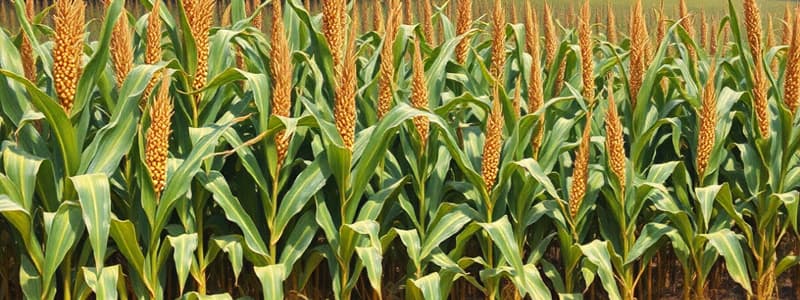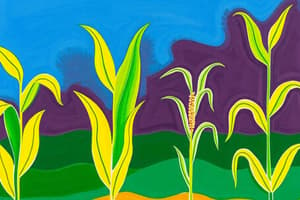Podcast
Questions and Answers
What does a Land Equivalent Ratio (LER) of less than 1.0 indicate?
What does a Land Equivalent Ratio (LER) of less than 1.0 indicate?
- Intercropping and sole cropping have equal productivity.
- Monocropping is more advantageous than intercropping. (correct)
- Intercropping is more productive than sole cropping.
- Intercropping is less productive than double cropping.
How is the Grain Yield measured in the intercropping of Mungbean and Peanut?
How is the Grain Yield measured in the intercropping of Mungbean and Peanut?
- By estimating the plant height.
- By counting the number of pods.
- By calculating the seed density.
- By weighing the harvested grains. (correct)
What method is used to determine the Weight of 1,000 seeds?
What method is used to determine the Weight of 1,000 seeds?
- Weighing 100 dry pods.
- Weighing 1000 clean, dried seeds. (correct)
- Counting seeds directly from the field.
- Estimating based on average pod weights.
Which variable is NOT used in the calculation of the Land Equivalent Ratio (LER)?
Which variable is NOT used in the calculation of the Land Equivalent Ratio (LER)?
What is the implication of a Land Equivalent Ratio (LER) of 1.0?
What is the implication of a Land Equivalent Ratio (LER) of 1.0?
What is the benefit of recording the number of seeds per pod?
What is the benefit of recording the number of seeds per pod?
Which of the following practices contributes to soil management in an intercropping system?
Which of the following practices contributes to soil management in an intercropping system?
In the context of intercropping, what is the significance of cleaning and drying grains to approximately 14% moisture content before weighing?
In the context of intercropping, what is the significance of cleaning and drying grains to approximately 14% moisture content before weighing?
What is the primary criterion for measuring days from seeding to tasseling?
What is the primary criterion for measuring days from seeding to tasseling?
Which measurement indicates that 80% of the plants have reached the boiling stage?
Which measurement indicates that 80% of the plants have reached the boiling stage?
What does a measure of 'weekly plant height (cm)' capture?
What does a measure of 'weekly plant height (cm)' capture?
How is the ear weight per plant determined?
How is the ear weight per plant determined?
What is the significance of measuring 'non-marketable yield (t/ha)'?
What is the significance of measuring 'non-marketable yield (t/ha)'?
Which method is used to count the number of ears per plant?
Which method is used to count the number of ears per plant?
What does the 'days from seeding to harvest' measurement represent?
What does the 'days from seeding to harvest' measurement represent?
How is the ear length measured?
How is the ear length measured?
What is the primary purpose of calculating marketable yield in tons per hectare?
What is the primary purpose of calculating marketable yield in tons per hectare?
How is the Land Equivalent Ratio (LER) calculated?
How is the Land Equivalent Ratio (LER) calculated?
Which of the following best defines the term 'days from seeding to tasseling'?
Which of the following best defines the term 'days from seeding to tasseling'?
What is the significance of measuring plant height in a crop study?
What is the significance of measuring plant height in a crop study?
What does the measurement of 'pods per plant' indicate in an intercrop study?
What does the measurement of 'pods per plant' indicate in an intercrop study?
What is the expected outcome when using an intercropping scheme?
What is the expected outcome when using an intercropping scheme?
What is meant by 'days from seeding to maturity' in crop production?
What is meant by 'days from seeding to maturity' in crop production?
Why is it necessary to record the total ear yield per hectare?
Why is it necessary to record the total ear yield per hectare?
What does the term 'growth stages' refer to in crop cultivation?
What does the term 'growth stages' refer to in crop cultivation?
What is an important factor in determining the success of intercropping systems?
What is an important factor in determining the success of intercropping systems?
Flashcards are hidden until you start studying
Study Notes
Data to be Gathered
- Corn (T1, T3, T4)
- Days from seeding to tasseling
- When 50% of plants produce tassels
- Days from seeding to silking
- When 50% of plants produce silk
- Days from silking to boiling stage
- When 80% of plants reach boiling stage
- Days from seeding to harvest
- Number of days from seeding to harvest
- Weekly plant height (cm)
- Measured from base to top of the tallest portion of the plant, from 10 randomly selected plants
- Number of ears per plant
- Count ears on 10 randomly selected plants
- Ear weight per plant (g)
- Weigh 10 randomly selected ears
- Ear length (cm)
- Measure length of 10 ears from the butt to the tip of the cob.
- Non-marketable yield (t/ha)
- Weigh the non-marketable ears, and convert to tons per hectare
- Total ear yield per hectare (t/ha)
- Add the weights of marketable & non-marketable ears, then convert to tons per hectare
- Days from seeding to tasseling
Intercrop (Mungbean & Peanut – T2, T3, T4 & T5)
- Days from seeding to flowering
- When 50% of the plants have produced flowers
- Days from seeding to maturity
- When 85% of plants have reached maturity and are ready for harvest
- Weekly plant height (cm)
- Measured from base to the tip of the tallest leaf, from 10 randomly selected plants
- Number of pods/plant
- Count pods per plant on 10 randomly selected plants
- Number of seeds/pod
- Count seeds per pod from 10 sample pods
- Weight of 1,000 seeds
- Weigh 1000 clean, dried seeds
- Grain yield (t/ha)
- Weigh the harvested peanuts and mungbeans (clean, dried at 14% moisture content) then convert to tons per hectare
- Land equivalent ratio (LER)
- LER is computed using the formula provided in article, LER of >1.0 means intercropping is more productive than sole cropping, LER of <1.0 means monocropping is more productive, whereas 1.0 is the equivalency point.
Studying That Suits You
Use AI to generate personalized quizzes and flashcards to suit your learning preferences.




